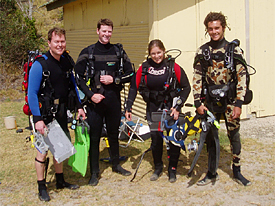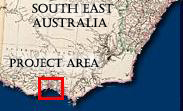
Flinders University 2008 Field School
in Underwater Archaeology
4 February 2008
By Mark Staniforth
Project Introduction
The 2008 Flinders University Underwater Archaeology Field School is currently being held at Portarlington in Victoria, Australia. This is the ninth annual Field School that we have conducted since 1998 and these have taken place in four Australian states (South Australia, Victoria, Tasmania and Queensland). Field school, as with many activities in the field of maritime archaeology, is a collaborative exercise and this year we are working with a number of individuals and organizations. Heritage Victoria, who we have worked with many times before including the 2004 Field School, is working with us and have brought along 3 boats, 2 vehicles and 4 staff. LAMP (the Lighthouse Archaeological Maritime Program) at the St. Augustine Lighthouse in Florida, USA has sent out Dr Sam Turner as part of an on-going staff exchange program that started in 2007 when 2 Flinders University faculty staff (Jen McKinnon and I) had the opportunity to visit St. Augustine and work with the LAMP staff during the 2007 Maritime Archaeology Practicum (ARCH 8109). We also have former graduates from the Maritime Archaeology Program volunteering their time as team supervisors including Andy Dodd from the New Zealand Department of Conservation, Peta Knott who holds a joint appointment at the Tasmanian Museum and Art Gallery and the Tasmanian Maritime Museum and Kellie Clayton who was a student at last year’s field school at Victor Harbor.
There are currently 27 people involved in the Field School comprising of 16 students (8 graduates, 6 undergraduates and 2 short course students), 3 staff (1 faculty member – Mark Staniforth, 1 technical officer –Jason Raupp and a PhD student on contract – Jun Kimura), 4 team supervisors (Peta Knott, Andy Dodd, Kellie Clayton and Sam Turner) and 4 Heritage Victoria staff (Peter Harvey, Cass Philippou, Hannah Steyne and an intern Agnes Milowka, who is also a student in the Maritime Archaeology Program). Students are organised into 4 teams each with four members and each team has been assigned a team supervisor. Each suitable weather day 3 boats go out (Devil Cat with a boat operator, dive supervisor, 1 team supervisor and 4 divers, the Stessl with a boat operator, 1 team supervisor and 2 divers and the Stacer with a boat operator, 1 team supervisor and 2 divers). This will allow two teams (each with their dive team supervisors) to get in the water plus one dive supervisor and 2 boat operators. Another team will dive on the Clifton Springs jetty or other shore dive site such as PS Ozone while the fourth team will usually fill tanks or draw up and write up results.

Figure 1 - PS Ozone at Indented Heads, Victoria. (Large View) (photo courtesy of the Maritime Archaeology Program at Flinders University).
All of the students have at least completed AIMA/NAS Part 1 training (a two day training course in basic maritime archaeology field methods) but some have extensive experience usually built up through years of involvement with avocational maritime archaeology groups such as SUHR (the Society for Underwater Historical Research in South Australia) and the UASBC (Underwater Archaeology Society of British Columbia in Canada). Many of the students have extensive backgrounds in archaeology (usually four year degrees in archaeology or anthropology) but we also have some Marine Biology and Aquaculture students with us as well. The principal aim of Field School is to get students working underwater and so the non-archaeology students are here to learn more about working in the underwater world.

Figure 2- Red Team ready to go into the water at PS Ozone (Large View) (photo courtesy of the Maritime Archaeology Program, Flinders University)
For most of us the Field School started out with a very long drive (11 hours) from Flinders University in the southern suburbs of Adelaide, South Australia to Portarlington but we also had students flying in to Melbourne from overseas including from Canada (Jody Bulman from Toronto who shares the prize with Sam Turner, from St Augustine, for coming the furthest) and New Zealand. We have a diverse group of people here from five different countries (Australia, New Zealand, USA, Canada and Japan). Accommodation is at the Portarlington Holiday Units which is a short walk from the main street. Weather to date has been mild and overcast (which helps to keep people from getting too sunburnt) and the water temperature a pleasant 20 degrees Celcius. Flinders University last ran a Field School at Portarlington in 2004.

Figure 3- Dr Sam Turner meets the local Australian wildlife (Sam is on the left) (photo courtesy of Mark Staniforth)
We hope you enjoy reading the Underwater Archaeology Field School Journal over the next two weeks.
Comments, questions, or suggestions?
For field school related issues please contact: mark.staniforth@flinders.edu.au
For website related issues please contact:
mua@keimaps.com
Return to Project Journal home page.

